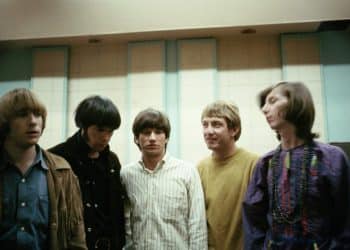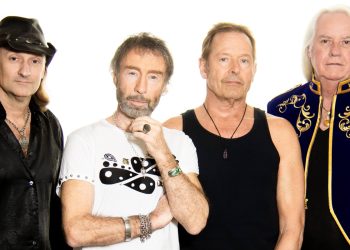Metallica, the titans of heavy metal, have been shaking the foundations of rock music since their formation in 1981. With their electrifying riffs, thunderous drums, and raw, emotive lyrics, they’ve crafted a legacy that resonates with millions worldwide. From headbanging anthems to soul-stirring ballads, their music spans a range of themes—from personal struggles to societal critiques, captivating audiences across generations.
In a career marked by groundbreaking albums and historic performances, Metallica has produced a treasure trove of iconic tracks. Whether you’re a die-hard fan or a newcomer to their sound, there’s no denying the impact of their most celebrated songs. In this article, we’ll dive into the top 10 most popular Metallica songs of all time, exploring what makes each track a timeless classic. From the explosive energy of “Enter Sandman” to the haunting melodies of “The Unforgiven,” we’ll uncover the stories and emotions behind these anthems that have defined a genre and inspired countless musicians. Get ready to crank up the volume and relive the magic of Metallica’s greatest hits!
1. Enter Sandman (1991)
“Enter Sandman” is more than just a song—it’s a cultural phenomenon that helped catapult Metallica into rock superstardom. Released as the lead single from their self-titled 1991 album (often called The Black Album), this track blends eerie storytelling with bone-crushing riffs, creating a perfect storm of heavy metal intensity. The song’s haunting theme revolves around childhood nightmares, capturing that eerie feeling of drifting into sleep while being stalked by something sinister. James Hetfield’s gravelly vocals and foreboding lyrics, paired with Kirk Hammett’s unforgettable riff, create an atmosphere that feels both thrilling and unsettling.
From the opening clean guitar notes that feel like a whispered warning to the explosive chorus that slams in like a nightmare taking form, “Enter Sandman” is structured to keep listeners on edge. The build-up in the bridge, featuring a whispered bedtime prayer, only adds to its chilling effect before the song explodes back into its signature riff. Lars Ulrich’s pounding drums and the song’s dynamic shifts create a rollercoaster of tension and release.
This track became Metallica’s biggest crossover hit, introducing them to mainstream audiences without sacrificing their edge. It remains a staple at their live shows, where the opening riff alone is enough to send an arena into a frenzy. Decades after its release, “Enter Sandman” still stands as a defining track of the heavy metal genre, proving that even our childhood fears can be transformed into legendary rock anthems.
2. Master of Puppets (1986)
“Master of Puppets” is a sonic juggernaut, an eight-minute thrash metal masterpiece that doesn’t just demand attention—it commands it. Released in 1986 as the title track of Metallica’s groundbreaking album, this song delves deep into the harrowing theme of addiction, portraying it as an unseen force that takes control, manipulating its victim like a puppet on strings. The lyrics are powerful and thought-provoking, delivered with Hetfield’s signature snarl, making it one of the most lyrically intense tracks in their catalog.
Musically, “Master of Puppets” is a perfect showcase of Metallica’s technical prowess. The song opens with an instantly recognizable riff, fast and aggressive, setting the stage for a relentless barrage of chugging guitars and pounding drums. But what makes this track truly exceptional is its structure—after the furious opening, the song takes a dramatic turn with a melodic, almost haunting midsection. Here, the tempo slows, the guitars become more intricate, and Hammett’s emotive solo weaves a sense of despair and helplessness into the track’s narrative. Then, like a sudden relapse, the song explodes back into its thrashy intensity, reinforcing the idea of addiction’s grip tightening once again.
Decades later, “Master of Puppets” remains one of the most celebrated heavy metal songs of all time. Its inclusion in pop culture—most notably in Stranger Things—has introduced it to a new generation of fans, proving that true metal never fades. Whether you’re headbanging in your bedroom or witnessing it live in a stadium, this track never loses its power.
3. One (1989)
“One” is a haunting and deeply emotional track that stands as one of Metallica’s most powerful and thought-provoking songs. Released on their 1988 album …And Justice for All, the song tells the story of a soldier who has lost his limbs, sight, hearing, and speech due to a horrific war injury, leaving him trapped in his own mind. Inspired by the anti-war novel Johnny Got His Gun, the lyrics paint a vivid picture of isolation and suffering, making it one of the band’s most lyrically intense compositions.
Musically, “One” is a masterclass in dynamic contrast. It begins with a delicate, sorrowful clean guitar intro, setting a somber mood before gradually building in intensity. Hetfield’s mournful yet raw vocals convey the soldier’s helplessness, while Lars Ulrich’s drumming starts off restrained but grows into an explosive force. The song eventually erupts into a thunderous assault of rapid-fire riffs, double-bass drumming, and Kirk Hammett’s scorching guitar solo, symbolizing the soldier’s silent screams of agony.
The accompanying music video, which incorporates scenes from Johnny Got His Gun, only amplifies the song’s gut-wrenching impact. “One” became Metallica’s first song to receive a music video, helping introduce them to a wider audience while maintaining their heavy, uncompromising sound. Today, the song remains a highlight of their live performances, often accompanied by dramatic pyrotechnics that enhance its devastating intensity. Few songs in metal history blend storytelling, emotion, and sheer power as perfectly as “One.”
4. Nothing Else Matters (1991)
“Nothing Else Matters” is one of Metallica’s most surprising and heartfelt songs—a stunning departure from their usual thrash-metal aggression. Released on The Black Album in 1991, the song showcases the band’s softer, more introspective side, proving that even the hardest rockers have a vulnerable core. Initially written by James Hetfield as a deeply personal love song, it was never intended for public release. However, once the band heard it, they recognized its emotional weight and decided to include it on the album.
The song opens with a delicate fingerpicked guitar melody, setting a mood of intimacy and reflection. Hetfield’s vocals are uncharacteristically gentle, brimming with sincerity as he delivers lyrics about devotion and trust. The orchestral backing, arranged by Michael Kamen, adds a lush, cinematic quality that elevates the track beyond traditional metal ballads. Kirk Hammett’s soulful guitar solo, played with an emotional restraint not often heard in their catalog, further enhances the song’s heartfelt message.
Despite some initial resistance from hardcore metal fans, “Nothing Else Matters” became one of Metallica’s most beloved and enduring songs. It’s often played at weddings, graduations, and special events, proving its universal appeal. Live performances of this track are often met with thousands of lighters (or phone screens) illuminating the crowd, turning it into a communal moment of shared emotion. Even after decades, “Nothing Else Matters” remains a testament to Metallica’s versatility and their ability to create music that resonates on a deeply personal level.
5. Seek & Destroy (1983)
If there’s one song that encapsulates the raw, rebellious energy of Metallica’s early years, it’s “Seek & Destroy.” Featured on their 1983 debut album Kill ‘Em All, this track is pure thrash-metal fury, embodying the band’s hunger, aggression, and no-nonsense attitude. With its driving riffs, galloping rhythm, and menacing lyrics, “Seek & Destroy” quickly became an anthem for metalheads worldwide.
From the opening riff, the song grabs you by the throat and doesn’t let go. The tempo is relentless, with Hetfield’s snarling vocals delivering a message of destruction and chaos. Lars Ulrich’s drumming is tight and energetic, while Cliff Burton’s bass work (in the original recording) adds an underlying groove that gives the song an extra layer of intensity. The extended solo section allows Kirk Hammett to showcase his shredding skills, reinforcing Metallica’s status as one of the most technically gifted bands in metal.
Over the years, “Seek & Destroy” has remained a fan favorite and a staple of Metallica’s live performances. The band often uses it as a set-closer, turning it into an extended jam session where they engage the crowd in chanting along. It’s the ultimate call to arms for headbangers, proving that even after four decades, Metallica’s early thrash-metal roots still hit just as hard.
6. The Unforgiven (1991)
“The Unforgiven” is one of Metallica’s most compelling and emotionally complex songs. Released on The Black Album, it marked a shift in their songwriting, incorporating deeper themes of regret, oppression, and self-reflection. Unlike traditional metal ballads, “The Unforgiven” flips the script by featuring softer, mournful verses that build into powerful, heavy choruses—creating a dynamic contrast that makes the song stand out.
The opening brass instrumentation immediately signals something different from the band’s usual sound. The verses, featuring Hetfield’s subdued, almost weary vocals, tell the story of a man struggling against societal expectations, only to realize too late that he has lost himself in the process. When the chorus hits, Hetfield unleashes a raw, anguished cry, symbolizing the character’s frustration and longing for redemption. Hammett’s soaring solo is packed with emotion, reinforcing the song’s melancholic tone.
This track resonated with fans on a deep level, leading to two sequels: “The Unforgiven II” (1997) and “The Unforgiven III” (2008). However, the original remains the most iconic, standing as one of Metallica’s most introspective and haunting pieces. Whether experienced through the studio version or the band’s mesmerizing live performances, “The Unforgiven” leaves a lasting impression, proving that metal can be just as powerful emotionally as it is sonically.
7. Sad But True (1991)
“Sad But True” is one of Metallica’s heaviest and most crushing songs, delivering a powerful punch both musically and lyrically. Released on The Black Album in 1991, this track showcases the band’s ability to create a slow, grinding groove that is just as intense as their faster thrash compositions. The song’s ominous theme revolves around inner conflict and self-destruction, with Hetfield’s lyrics exploring the idea of being controlled by one’s darker impulses—almost like a sinister force lurking within.
From the first note, the down-tuned, chugging riff immediately sets a menacing tone. Unlike their breakneck thrash anthems, “Sad But True” relies on sheer heaviness, with every note hitting like a sledgehammer. Hetfield’s vocal delivery is raw and commanding, perfectly complementing the song’s dark subject matter. Lars Ulrich’s drumming, with its slow but thunderous pounding, adds to the song’s relentless intensity, making it one of Metallica’s most brutal-sounding tracks.
Over the years, “Sad But True” has remained a standout in Metallica’s live shows. The massive, arena-shaking riff makes it a fan favorite, with the audience chanting along to the chorus in unison. The song’s dark themes and heavy groove have also inspired several covers, including a famous reimagining by Kid Rock in his song “American Badass.” Whether you experience it through the album or live in concert, “Sad But True” is an undeniable force—a reminder of Metallica’s ability to create music that is both bone-crushingly heavy and deeply resonant.
8. Fade to Black (1984)
“Fade to Black” is one of Metallica’s most haunting and emotionally charged songs. Released on Ride the Lightning in 1984, this was the band’s first true ballad, marking a turning point in their songwriting and proving that thrash metal could carry deep emotional weight. The song explores themes of despair, depression, and existential struggle, with lyrics that speak to feelings of loss and hopelessness. For many fans, “Fade to Black” serves as a cathartic anthem—one that gives voice to emotions that are often difficult to express.
The song’s structure is a masterpiece of dynamic progression. It begins with a sorrowful acoustic guitar melody, setting a somber tone before transitioning into heavier sections that gradually build in intensity. Hetfield’s vocals start off subdued and reflective, but as the song progresses, his delivery becomes more desperate, mirroring the emotional turmoil within the lyrics. The climactic guitar solo by Kirk Hammett is one of his most iconic—an expressive, wailing cry of pain that perfectly encapsulates the song’s themes.
Though controversial at the time for its melancholic subject matter, “Fade to Black” has since become one of Metallica’s most beloved songs. It’s a staple of their live performances, often met with thousands of fans swaying their arms in the air. The song’s ability to channel deep emotions through powerful music has solidified its place as one of the greatest metal ballads of all time.
9. For Whom the Bell Tolls (1984)
Few Metallica songs are as instantly recognizable as “For Whom the Bell Tolls.” Released on Ride the Lightning in 1984, this song is a thunderous and cinematic depiction of war, inspired by Ernest Hemingway’s novel of the same name. The lyrics paint a vivid picture of soldiers trapped in the chaos of battle, fighting bravely but ultimately meeting their fate. With its ominous atmosphere and relentless rhythm, this track has become one of Metallica’s most enduring anthems.
One of the defining elements of “For Whom the Bell Tolls” is its legendary bass intro—an eerie, distorted riff played by Cliff Burton that sounds more like a lead guitar than a bass. This unforgettable opening sets the stage for the slow, crushing rhythm that follows. The song moves at a steady, pounding pace, with Hetfield’s powerful vocals delivering the grim tale of soldiers standing their ground in the face of death. Lars Ulrich’s drumming adds a militaristic feel, reinforcing the song’s battlefield themes.
Over the decades, “For Whom the Bell Tolls” has remained a staple of Metallica’s live shows. The crowd often chants along to the chorus, and the song’s massive, unrelenting groove makes it a favorite for headbangers. The track’s ability to capture the chaos and heroism of war, combined with its crushing musicality, has made it one of Metallica’s most celebrated songs.
10. Wherever I May Roam (1991)
“Wherever I May Roam” is a song that perfectly captures the restless spirit of a wandering soul. Released on The Black Album in 1991, this track explores themes of independence, self-reliance, and the nomadic lifestyle that comes with being a musician—or anyone constantly searching for meaning beyond the constraints of society. With its mysterious Eastern-influenced intro and crushing heaviness, the song stands out as one of Metallica’s most epic and adventurous compositions.
The track begins with a haunting, sitar-like guitar melody, setting an atmosphere of mystery and exploration. As the main riff kicks in, the song transforms into a powerful, driving force, with Hetfield’s lyrics declaring his unbreakable spirit and refusal to be tied down. The chorus, with its anthemic declaration—”Wherever I may roam, where I lay my head is home”—has resonated with countless fans who relate to the idea of forging their own path in life.
Musically, “Wherever I May Roam” is both heavy and atmospheric, with a mid-tempo groove that allows each instrument to shine. Kirk Hammett’s solo is soaring and expressive, adding to the song’s grand, open-road feel. Live performances of the track often include extended instrumental sections, making it one of Metallica’s most immersive experiences in concert.
Decades after its release, “Wherever I May Roam” remains a powerful anthem for those who embrace a life of adventure and self-discovery. Its message of freedom and resilience, combined with its massive sound, ensures its place as one of Metallica’s greatest and most enduring songs.









